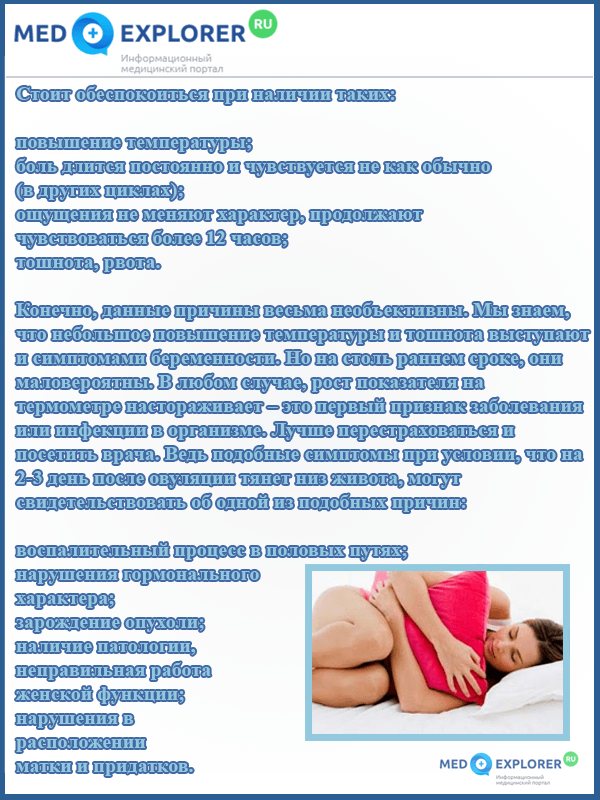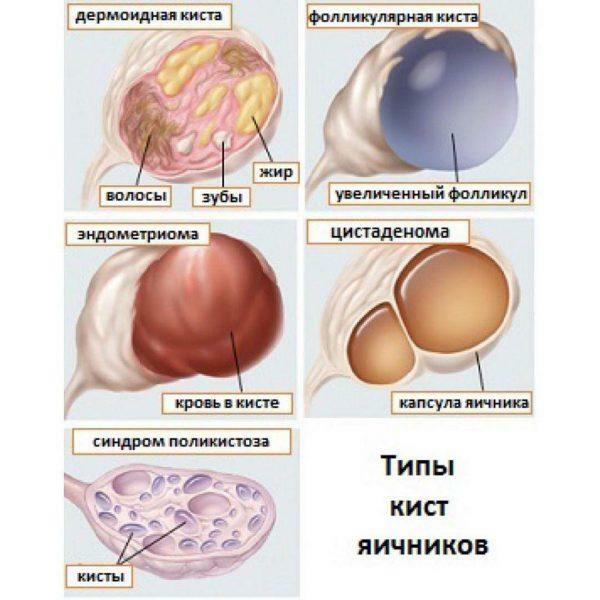The first signs of cerebral palsy can be found in newborns in the first days of life and up to a year. Professional specialists and even parents can determine the presence of the disease in the first stages of development, which is necessary to prevent exacerbations. Cerebral palsy in children is often manifested by a complex of symptoms that need to be recognized in a short time.
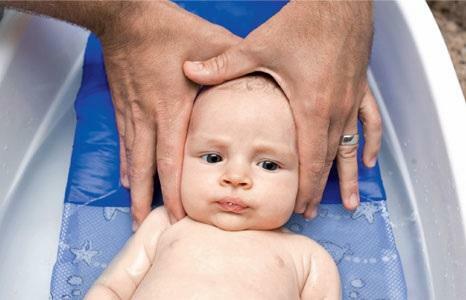
Characteristics of cerebral palsy in a child up to the year
Content of material
- 1 Main signs of cerebral palsy in children under one year
- 2 How to identify cerebral palsy in a three-month-old child?
- 3 How to recognize cerebral palsy in a baby?
- 4 Common signs of cerebral palsy
- 4.1 Diplegic form
- 4.2 Hemiplegic form
- 4.3 Video - How to recognize cerebral palsy
- 4.4 Hyperkinetic form
- 5 When should I be alerted?
The main signs of cerebral palsy in children under the age of one year
It is not always the doctors who properly examine the child in order to identify symptoms of cerebral palsy in time. Parents spend a lot of time with the baby, because of what they have a chance to independently detect the disease. The most characteristic appearance of cerebral palsy at an early age:
- Inability to detect creases between the buttocks.
- No lumbar flexion.
- Asymmetry of two parts of the trunk.
In the first days of life with expressed cerebral palsy, such signs can be diagnosed:
- Excessive muscle tone or their being in a relaxed state.
- In the first days of life the optimal muscle tone is traced, but after a while it disappears.
- If hypertension occurs, the child's movements look unnatural, often too slow.
- Unconditioned reflexes do not disappear, and the child does not start to sit for too long, keep his head on his own.
- Asymmetry of various parts of the body. On the one hand there are symptoms of hypertonia, with the second may be a weakening of the muscles.
- Muscle twitching, in some cases full or partial paralysis is possible.
- Unreasonably increased anxiety, frequent loss of appetite.

What is cerebral palsy for children
Note! If the child actively uses only one side of the body, the other part is gradually atrophy of the muscles, the limbs develop inadequately, often do not grow to the necessary parameters. There is a curvature of the spine, abnormalities in the work and structure of the hip joints.
Most often, cerebral palsy in children is detected quickly, as they perform active movements of limbs located on one side. Often, patients almost do not use a hand with a weakened tone, which rarely separates from the trunk. The child does not turn his head without applying great efforts even a few months after birth. Often parents have a need to turn the baby from time to time.
Even if you do not notice any dangerous signs or doubt their availability, you should regularly perform diagnostic tests. Be attentive to the child's health, if he was born prematurely, develops too slowly, you notice problems during childbirth.

Signs of cerebral palsy in the child 2 months
Note! If you find a serious deviation in the development, the peculiarities of the behavior of the infant, it is necessary to consult a doctor for advice.
Methods of self-diagnosis of cerebral palsy :
| Method | Features |
|---|---|
| Absence of characteristic reflexes | After birth, infants have characteristic reflexes, which then gradually pass. If the child is healthy, a blinking reflex appears in response to a strong noise. In case of cerebral palsy, this feature is often not manifested |
| Similar movements of | If you suspect your child of cerebral palsy, check to see if repeated movements occur. The presence of cerebral palsy often indicates a constant nodding, congealing in a particular posture for a long period of time. If you notice such abnormalities, it is advisable to consult a pediatrician |
| Touch reaction | To check if a child has a dangerous disease, you can put his palms on his stomach. If you have not noticed a particular reaction in a child, most likely the disease is absent, at least not manifested in a pronounced form. In the presence of pathology, the legs will be raised in opposite directions. The severity of negative symptoms depends on the level of brain damage. |

Signs of cerebral palsy in the first 3 months of the child
How to identify cerebral palsy in a three-month-old child?
In the period from 3 months to 6 months, the child exhibits congenital reflexes, including palmar-oral, calcaneal. The presence of the first can be checked by pressing your fingers on the inside of the brush, and the child opens his mouth. To check the presence of a calcaneal reflex, it is necessary to raise the child, placing it on its feet. Usually, the kids try to move. In a healthy state, the child becomes fully fat. If cerebral palsy manifests itself, it rests only on the fingertips or at all, it can not engage the legs for support.
At 3 months, you can quickly diagnose cerebral palsy if the child actively uses only one side of the trunk. In many cases, this symptom can be found only a few days after the birth of the child. Insufficient muscle tone on one side and hypertension on the other are caused by pathologies of the relationship between the two hemispheres of the brain.

First signs of cerebral palsy
If the innervation is not performed correctly, the child's movements become clumsy, he uses the opposite parts of the body in different ways, and the inhibited reaction is manifested. Manifestations of cerebral palsy can be seen even on the face. There may be a complete absence of chewing muscles, which causes asymmetry in the muscles of the face. Often develops strabismus.
Note! Sick children often can not sit on their own, and this deviation can persist for up to six months or longer.
How to recognize cerebral palsy in a baby?
If brain damage is minimal, typical symptoms are difficult to identify not only to parents, but even to professional professionals. Clunky movements, overstrain of muscle tissue are noted only when the brain cells are severely damaged.
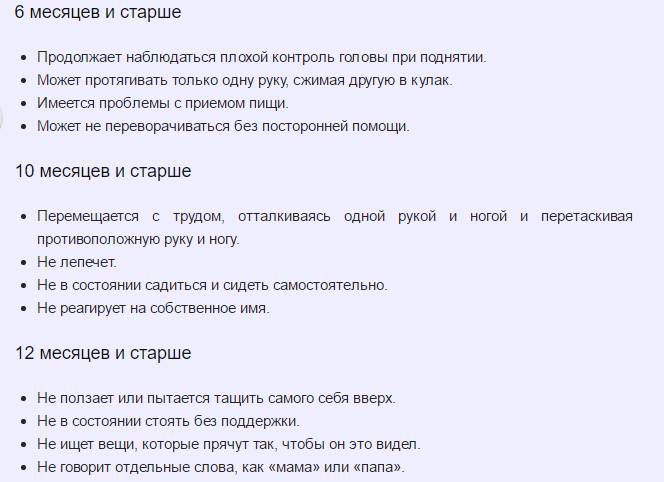
Symptoms of cerebral palsy at 6, 10 and 12 months
It is possible to suspect cerebral dysfunction in the presence of such symptoms:
- Sleep pathologies.
- The inability to turn over.
- The child does not hold his head.
- Conditional reflexes extend only to one side of the body.
- The baby is often in one position, not moving for a long time.
- Periodically, convulsions occur in the limbs.
- Face asymmetry of varying severity.
- The extremities differ in length.
Common signs of cerebral palsy
The clinical picture may vary depending on the form of the disease. Each of them is characterized by specific symptoms that affect the life of the child in different ways.
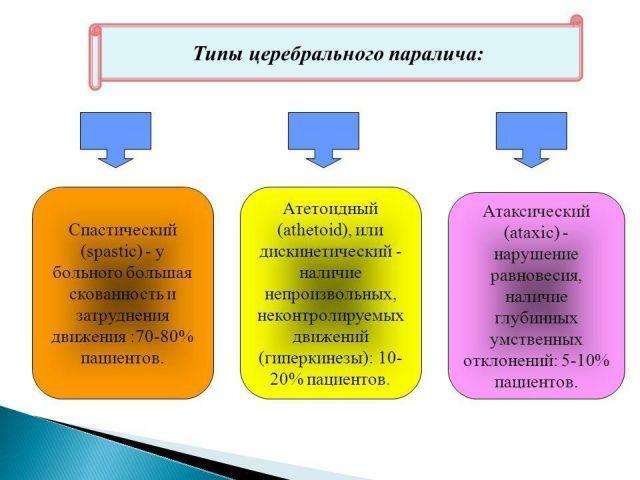
Types of cerebral palsy
Diplegic form
Occurs when damage to the brain occurs during the period of intrauterine development. These disorders can be seen on the hypertonic muscle. Sick children are in a characteristic position, as their legs are stretched, often crisscross.
Up to a year you can see that the child practically does not use the lower limbs when moving. Often children do not try to sit down, even roll over. With the aggravation of the course of the disease, it is possible to develop serious abnormalities in physical development.
To detect the presence of this form of the disease is easy enough. It is enough to try to put the child to his feet. In this case, there is a sharp increase in muscle tone. The child moves, and only rests on the chicks. The gait is not very strong, with each new step the child touches one foot with the other, moving the limbs directly in front of him.
Note! Diplegic form of the disease often manifests deviations in mental development.
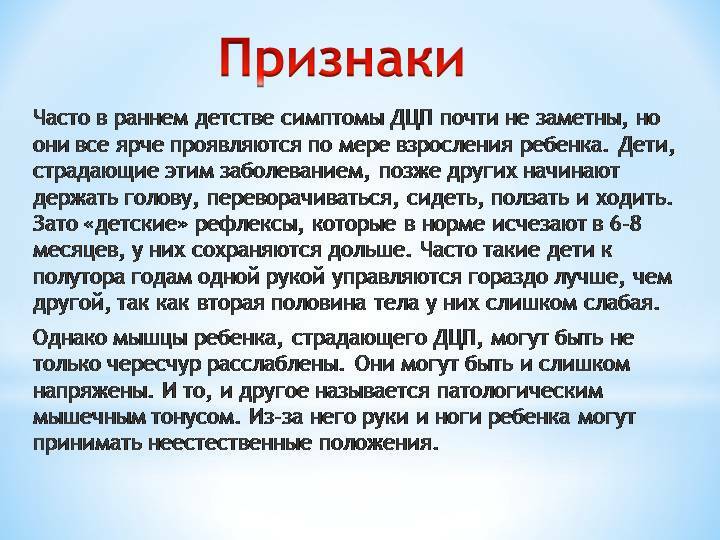
Symptoms of infantile cerebral palsy
Hemiplegic form
The disease often occurs when one of the cerebral hemispheres is affected. A high risk of developing hemiplegic form of cerebral palsy is preserved in children suffering from intrauterine infection. This disease can occur even with a small hemorrhage during childbirth.
The hemiplegic form of cerebral palsy is manifested by the limited movements in the limbs, while the constantly elevated muscle tone is preserved. The child is actively moving, but at the same time he is diagnosed with too frequent contraction of muscles in the part of the trunk, for the innervation of which corresponds to the affected area of the brain.
Video - How to recognize cerebral palsy
Hyperkinetic form
Occurs when structural disorders of the subcortical ganglia responsible for innervation occur. Often, the disease manifests itself with negative immune activity in the body of the mother in relation to the child. In this case, the symptoms of cerebral palsy are also pronounced. Muscular tone in the child is often stabilized, but after a while, it increases. In some cases, muscle tone does not increase, but decreases. The child's movements become awkward, he takes uncomfortable and unnatural poses. In many cases, this form of the disease retains intelligence, which is why the prognosis for timely treatment is considered conditionally favorable.
When should I be alerted?
There are several types of symptoms by which you can determine the severity, the form of the disease. Often, negative signs are very clear, which makes it almost impossible not to notice even at the age of one year. In most cases, cerebral palsy manifests itself as severe symptoms, impairments often lead to impairment of motor, coordination functions.

Forms of cerebral palsy
Motor signs of cerebral palsy:
- Hyperkinetic form of this disease.
- Dystonia, associated with it disorders.
- Development of motility on only one limb.
- Spasticity of muscles.
- Periodic appearance of paresis, paralysis.
Dystonia during cerebral palsy progresses steadily, after a while there are additional negative symptoms, which can lead to a number of complications. Often progression is not cerebral palsy, but associated with it disorders, diseases. During the active growth of a child, the intensity of negative symptoms can both increase and decrease.
Often, cerebral palsy after some time is complicated by structural pathology of the joints, impaired muscle. These deviations are almost impossible to stop if you refuse to use surgical intervention.

Methods of treatment of cerebral palsy
Note! Often, pathologies occur as a result of disruption of certain areas of the brain. As a result, patients suffer from improper operation of the muscles, and deviations in the functioning of internal organs are also possible.
In the event of a disruption in the brain, the following disorders can occur:
- Non-standard, illogical behavior.
- Impossibility to learn something new, to say simple words.
- Intellectual insolvency.
- Hearing disorders, speech pathology.
- Regular occurrence of problems with swallowing.
- Insufficient appetite.
If cerebral and neurological disorders occur in cerebral palsy, the quality of life of babies is greatly reduced. In some cases, concomitant diseases affect the human body more than primary pathologies. Often cerebral palsy is accompanied by a decrease in intelligence, a defeat of various structures of the brain.
Cerebral Palsy in children is often characterized by standard signs, but it can follow a unique pattern. To determine the presence of cerebral palsy, especially in light forms, special tests are used. Based on a group of symptoms, the disease is detected. Doctors consider the combination of signs from the side of muscle tissue and the nervous system.
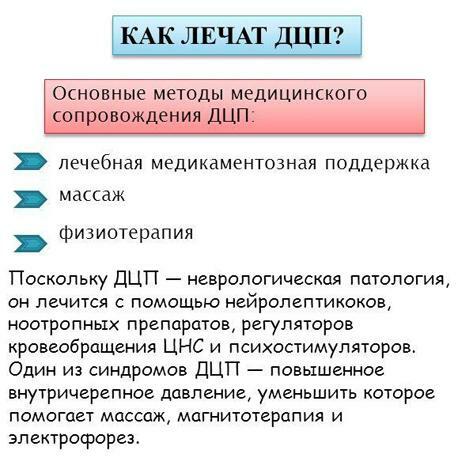
Medical methods of treatment of cerebral palsy
To make an accurate diagnosis, to determine the dynamics of the disease, doctors use various diagnostic measures. Negative signs often appear from the first days or weeks of a baby's life. To diagnose, describe the course of the disease can be up to a year, but the information is refined at an older age.
Diagnosis of cerebral palsy is carried out using an evaluation of the general condition of the brain. Modern instrumental technologies are used, including MRI, CT, ultrasound. With the help of these diagnostic studies, it is possible to identify pathological foci, disorders in the structure of the brain, as well as areas of hemorrhage.
The deterioration of the clinical picture can be traced using neurophysiological methods of investigation. Electromyography and similar activities are carried out. Laboratory and genetic diagnostic methods are used to determine the symptom characteristic of cerebral palsy.
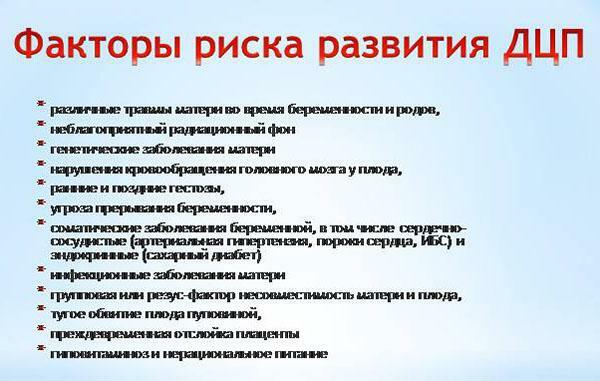
Risk factors for cerebral palsy
cerebral palsy during severe stages often manifests itself in conjunction with such abnormalities:
- Epileptic seizures.
- Hearing loss.
- Pathology of vision. Caused by atrophic processes in the discs of the optic nerves.
cerebral palsy often manifests itself in conjunction with a set of concomitant symptoms, which is why it is often diagnosed in the first year of life. If cerebral palsy occurs with a genetic predisposition to brain damage, the disease progresses steadily. In many cases, you can eliminate the negative symptoms of the disease if you seek medical help in a timely manner.

